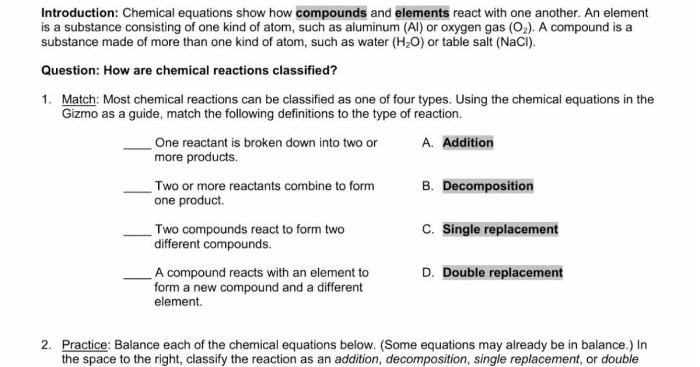Embark on a scientific odyssey with the Student Exploration Chemical Changes Gizmo Answer Key, a comprehensive guide that empowers students to unravel the mysteries of chemical transformations. This meticulously crafted resource unveils the intricacies of chemical reactions, providing a profound understanding of the fundamental principles that govern the molecular world.
Through engaging experiments and in-depth analysis, the Chemical Changes Gizmo unveils the secrets of chemical changes, enabling students to witness firsthand the dynamic interactions between substances. This interactive tool fosters a deeper comprehension of reaction types, reaction indicators, and the variables that influence chemical processes.
Overview of Chemical Changes Gizmo
The Chemical Changes Gizmo is an interactive simulation that allows students to explore various chemical reactions and observe the accompanying changes. It provides a virtual laboratory environment where students can manipulate variables, collect data, and analyze results to understand the fundamental principles of chemical change.
The Gizmo features a range of experiments, including reactions between acids and bases, combustion reactions, and redox reactions. Students can control reaction conditions, such as temperature, concentration, and the presence of catalysts, to investigate how these factors influence the rate and extent of chemical reactions.
Types of Chemical Changes
Acid-Base Reactions, Student exploration chemical changes gizmo answer key
- Involve the transfer of protons (H+) between an acid and a base.
- Produce salt and water as products.
- Can be identified by the formation of bubbles (carbon dioxide gas) when an acid reacts with a carbonate.
Combustion Reactions
- Occur between a fuel and an oxidant (usually oxygen).
- Release large amounts of heat and light.
- Produce carbon dioxide and water as products.
- Can be identified by the presence of a flame.
Redox Reactions
- Involve the transfer of electrons between reactants.
- Can be identified by changes in oxidation states of the reactants and products.
- Often involve the formation of colored products.
Experimental Procedures
To conduct experiments using the Chemical Changes Gizmo:
- Select an experiment from the menu.
- Manipulate the variables and parameters as desired.
- Start the reaction and observe the changes that occur.
- Collect data, such as temperature, volume, and color changes.
- Analyze the data to draw conclusions about the chemical reaction.
Data Analysis and Interpretation

Students can collect data from the Gizmo experiments using the built-in data collection tools.
To analyze the data:
- Plot graphs of the data to identify trends and patterns.
- Calculate rates of reaction and equilibrium constants.
- Compare the results of different experiments to draw conclusions about the effects of variables on chemical reactions.
Applications and Extensions
The concepts explored in the Chemical Changes Gizmo have numerous real-world applications, including:
- Understanding chemical reactions in everyday life, such as cooking and cleaning.
- Developing new materials and technologies.
- Predicting and controlling chemical reactions in industrial processes.
Extension activities could include:
- Designing and conducting their own chemical reactions.
- Investigating the effects of different catalysts on reaction rates.
- Exploring the relationship between chemical reactions and energy changes.
Query Resolution: Student Exploration Chemical Changes Gizmo Answer Key
What is the purpose of the Chemical Changes Gizmo?
The Chemical Changes Gizmo is an interactive simulation that allows students to explore different types of chemical reactions and observe the changes that occur.
What are the different types of chemical changes that can be demonstrated with the Gizmo?
The Gizmo can demonstrate a variety of chemical changes, including synthesis, decomposition, single displacement, double displacement, and combustion reactions.
How can students use the Gizmo to collect and analyze data?
Students can use the Gizmo to collect data on the mass of reactants and products, the volume of gases produced, and the temperature of the reaction. They can then use this data to analyze the chemical changes that have occurred.
